 John Henn 1887
John Henn 1887
Church History: Page One (to 1844) || Page Two (1844-1879) || Page Four (1926-1965) || Page Five
This portion of my web site contains the text of a history of my local parish church which I wrote in 1979.
Minor amendments have been made (c)2005.
THIS TEXT IS COPYRIGHT 1979 BY STEPHEN SHAW. THE AUTHOR ASSERTS HIS RIGHT TO HAVE HIS NAME ASSOCIATED WITH HIS WORK.
THE INFORMATION IN THIS BOOK IS FREE. It may be copied, distributed and/or modified under the conditions set down in the Design Science License published by Michael Stutz
Stephen Shaw ENGLAND
The places in which these people lived have also been variously named on old maps, with Parsonage appearing quite often. We have several of these places on old maps of the Heatons, but cannot tie any of them down to the clergy who looked after St Thomas. The waters are muddied by the tradition of clergy actually living outside their parish - or having the care of several parishes at once. The Parish of St Thomas has only owned the one rectory site, on Heaton Moor Road.
A book by J Hooley (Old taverns, Inns and Public Houses in Stockport) refers to The Grapes on Old Road as having once been an old parsonage house for St Thomas, converted into an Inn about 1820. But which St Thomas? It may have merely been the place where a minister lived rather than a church owned curacy, and we have nothing in the records of St Thomas Heaton Norris to link to the premises. Mr Myddleton, the Curate from 1809 clearly lived outside the town.
The old Rectory was extended in 1880, for which the Governors of Queen Anne's Bounty granted a mortgage of GBP 800 (which was finally paid off in 1921).
Mr Rogers was reported to be in poor health in 1886, 1887 and 1888. He died in Bedford in 1910.
Church records hold a specimen of Mr Rogers signature in which his name has been spelled ROGSRE, which may be due to ill health, an early example of dyslexia? or someone else secretly signed on his behalf.
 John Henn 1887
John Henn 1887
Mr Henn came to Manchester in 1855, as Head Master of the Manchester Commercial Schools, taking his BA in 1857. He was ordained Deacon in 1858, and Priest in 1859.
From 1858-1860 Mr Henn was Curate at St John's, Manchester (demolished 1931).
John Henn played an important role in the founding of the Manchester and Salford Hospital Sunday Fund, founded in 1870. Given his part, and the current commercial status of the Fund, I am going to devote some time here to discuss the Fund - although not strictly Church related.
At his death in 1888, John Henn was considered as the founder of this nationwide hospital charity movement ("although there are other claimants"). The following is a quotation from John Henn himself, dated 1875: "Cannon Miller began what he called "Periodical Collections for Local Charities" in Birmingham in 1858. It was on the model of this I started our Hospital Sunday Fund here, and all the rest of the Hospital Sundays are copies of ours". The question of who started it all remains a question.
The official history of the movement indicates that a Hospital Sunday Fund was established in Birmingham in 1858, and during his visits home Mr Henn may have heard of it. He played a prominent part in establishing the Manchester Fund, and was the first Secretary and General Manager. His enthusiastic support may have played an important part in spreading the idea.
At this time hospitals very much relied upon voluntary donations, and on Hospital Sunday, organised by the Fund, participating Churches paid all the collections for the day to the Fund, which then distributed the monies to the various hospitals in the area.
In Liverpool in 1871, a Saturday fund was established, collecting donations from workers and this idea was quickly copied in Manchester. The Sunday Fund fell into disuse, but the Saturday fund still existed in 1979, in a mildly differing format and the idea continues in a commercial format today. The Fund was incorporated in 1907 in order to enable it to purchase convalescent homes - donating workers were entitled to stay in these free of charge as required.
In 1928, subscribers were entitled to free hospital treatment which was then not generally available. As the National Health Service was introduced, payments to subscribers became a payment of lump sums for each nights stay in hospital, unrelated to medical costs, although other medical bills (for example dental and optical) were paid up to a limit, and this remains the basis of the plan, which is no longer charitable but now fully commercial. It is not strictly medical insurance. In 1979 when this book was written, the correct title of the fund was The Manchester and Salford Hospital Saturday and Convalescent Homes Fund.
In 1979, a subscription of just 15p per week entitled members to the then still available convalescent homes, cash payments when in hospital, and cash help with those items of healthcare the NHS does not fund such as optical and dental work. Much of the subscriptions paid for the benefits, but the tradition of assisting hospitals continued, such as the intensive heart care unit at Hope Hospital.
Since then the insurance business in general has discarded the old traditions of permanance and reliability, with fund closures, exceedingly poor investment returns, and multiple mergers and name changes leaving customers confused and looking elsewhere for long term financial security.
In 1999 our Saturday Fund merged with Healthcare Insurance Alliance (being Hospitals Guild of Northampton and Anglia Healthcare), and then became HealthSure Group Ltd , a wholly owned subsidiary of Health Innovation Service Group Ltd. Now in 2005, HealthSure has merged with HSA (formerly Hospital Savings Association). You can check their website for current benefits and costs- but note that this is now a fully commercial concern.
Back to our Church History now...
The period of Mr Henn's incumbency was an active one.
The area around the church was now being developed, and the ancient footpath along the side of the Church became a road, possibly known as St Thomas Road, but now Buckingham Road.
On 17th July, 1890, a service of dedication was held at 7.45pm to dedicate the Lych Gate, erected in memory of T Beaumont, for many years a warden. Originally this had a gas light installed (street lighting was by no means as bright as it now is). In the same year iron railings were added to the boundary wall (removed for scrap in WW2).
By 1889 the school had to be enlarged. Lord Egerton offered a plot of land of three quarters of an acre at a rent of GBP 15 per annum. This was some distance from the existing building, and it would appear that there was some disagreement with his Lordship over the conditions he wished to impose on the transaction. During the course of negotiations a tender of GBP2,530 from W Southern and Sons was accepted.
In 1891, the committee decided to obtain land adjacent to the existing school, and a plot [of 1891 square yards?] was purchased from a Mr R Scott at a rental of GBP25 per year, which was still being paid in 1979.
Plan of School Lands around 1900. Use back button to return to this page.
The newbuilding was designed to have another storey added at a later date if further enlargement was required (although subsequent expansion has been single story only) and the cost was largely funded by a four day bazaar held in the Conservative Hall on Heaton Moor Road, which raised GBP1,337.
[Update: In 2014 the buttressed 1891 building received -at last- another storey, as a flat ceiling was inserted into the former school hall, and windows inserted into the newly roofed area above] This was not quite enough, and the builder began to charge 5% interest on the outstanding balance. To pay him off, a further bazaar was held, this time raising only GBP 713, but when some donations had been received it was enough to pay the bill off.
The building then erected still stands, and forms the main school hall and offices. The original school of 1866 has been demolished.
The funds raised had been deposited in the Lancashire and Yorkshire Bank, which had been founded just twelve years previously. The bank branch has moved its address, and changed its name twice- first to Martins Bank, then to Barclays Bank - and in 1979 the Church still maintained an account with them.
The list of contributors included Lord Egerton (who seems again to have made conditions), Ellis Sykes (the name of a large Stockport shop up to the sixties), and Sir W H Houldsworth (owner of Houldsworth Mill).
The second plot of land was purchased free of covenants or restrictions, however the Church subsequently conveyed the land to a Mr E Watkin, forming a Trust and making the legal ownership of this land in the event of a closure of the school, quite a complex matter! With regard to the original plot of school land, the Church had right to purchase the reversionary rights from Lord Egerton's estate.
In 1893 the Church was painted with scriptural passages decorating the chancel arch and the walls.
In 1897 - the year of Queen Victoria's Diamond Jubilee - the old Renn organ was replaced by a three manual organ installed by Jardine and Co Ltd at a cost of GBP 700.
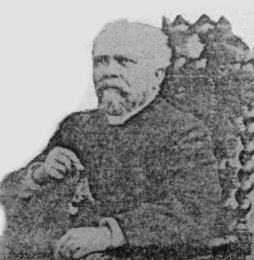 John Henn 1898.
John Henn 1898.
In the late 1890's the 1822 pub opposite the chapel , called The Chapel House, was rebuilt.
John Henn became an Honorary Canon of Manchester Cathedral during Jubilee Year
Ill health caused him to resign the living in December 1900, and he later died in 1903.
During Mr Henn's incumbency the average attendance at Communion was about 50, but he did bring about a large increase in the number of communicants for the Christmas and Easter services- for example:
Christmas Communicants in 1980=62, 1891=75, 1892=116, increasing to over 150 by the time he left.
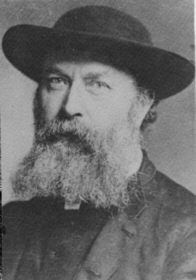 Mr Brayshaw was formerly the Second Master of the Surrey County School. He became Curate to Archdeacon Musgrave at Halifax, and then Rector of Holy Trinity in Hulme (Manchester).
Mr Brayshaw was formerly the Second Master of the Surrey County School. He became Curate to Archdeacon Musgrave at Halifax, and then Rector of Holy Trinity in Hulme (Manchester).Before his appointment to St Thomas, Mr Brayshaw had already visited the Church - he preached here in 1890.
Mr Brayshaw was advised to retire by his doctor and did so in 1907. He died in 1920 in the area of Chapel en le Frith.
Images from the period


Compare the church exterior in 1905 with the same view in 1979.
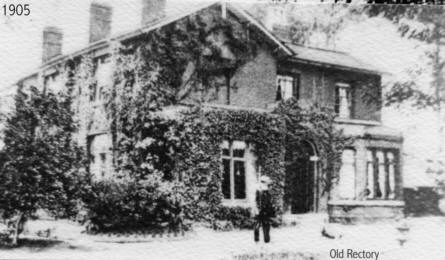
 Compared to Mr Brayshaw's ministry, for which the Church records show no activity of note, Mr Sutcliffe's ministry was a very active one. Earlier in 1893-96 Mr Sutcliffe was Curate of St Clements in Salford. He had a short first marriage, married 1890, his wife died 1891 but he remarried in 1903.
Compared to Mr Brayshaw's ministry, for which the Church records show no activity of note, Mr Sutcliffe's ministry was a very active one. Earlier in 1893-96 Mr Sutcliffe was Curate of St Clements in Salford. He had a short first marriage, married 1890, his wife died 1891 but he remarried in 1903.In addition to the tragedy of the First World War, both before and after the war, the country saw much unrest, and our Parish records make frequent mention of strikes and labor unrest.
In 1910 electricity arrived at St Thomas, to power an electric organ blower and electric lighting. This early supply was at 200 volts D C.
In 1912 a new boiler was purchased for GBP 21, presumably for a central heating system, possibly installed in 1874.
1913- Heaton Norris Urban District Council came to the end if its time, and Heaton Norris was henceforth administered entirely by Stockport Borough Council, who seem to have had an interest in the area as early as 1894. The area we call Heaton Chapel was thus under three forms of administration- civil administration under Stockport, Cheshire; Church administration under Manchester Diocese; and Legal jurisdiction under Lancashire.
A Parish Magazine from March 1915 has some interesting details from this time:
The Church title on the front is "St Thomas' Church, Heaton Chapel, otherwise Heaton Norris"
In addition to regular Sunday morning and evening services at 10.30am and 6.30pm, Communion was held weekly at 8am, and twice a month at noon. There was a monthly children's service at 2.45pm.
"Applications for Pews can be made to the Churchwardens or Sidesmen"
Confirmations were held at St Paul's Heaton Moor on March 18th 1915.
During the year 1914 the Church donated ten pounds to the Church Missionary Society schools at Kokrakulam.
A table of offerings for February 1914 should perhaps read 1915! This indicates varying applications of the collections- one Sunday nearly Pounds 20.25 was paid to the Hospitals Fund (referenced above under John Henn); on two Sundays the collection went to Church Expenses (total Pounds 11.55) and on the remaining Sundays the collection was applied to something called "Sick and N"(eedy) totalling 43p.
The total communicants for February 1915 was 84.
A letter was received from Buckingham Palace thanking the Sunday School for Pounds 4.43 towards the Queen's "Work for Women" fund.
Link to images of 1915 Magazine
The Church of England introduced its taxation of churches, known as the Quota system, in 1915. Under this system Parish Churches were asked to contribute towards the cost of central administration costs of the Diocese. St Thomas was "about the only Church not to pay in full" and for at least the next ten years this state of affairs continued. Our parish started with a fairly poor record of contributions, and later lapsed again, improving somewhat by 1979.
A large biscuit works was opened in 1918, McVitie and Price, later McVities, part of United Biscuits. In this location chocolate covered biscuits such as Penguin and Jaffa Cakes were (and are) manufactured.
Although lightning conductors were first used elsewhere in 1769, it was not until 1918 that they were fitted to St Thomas. At the same time six fire extinguishers were purchased.
In the country as a whole, during 1919, thirty four million working days were lost in strike action, and by 1920 this had increased to eighty six million. For comparison, in 1984, the year of the major coal strike, only 27 million days were lost (some 80% accounted for by the coal miners strike).
The Parish records show that a Parish Council (as distinct from the Vestry, the original administrative body) met in St Thomas from 1909. This was a fore-runner of the Parochial Church Council which was established in that troubled year of 1920. The P C C shared the responsibilities of the Church Wardens, and introduced lay participation in the affairs of the Church.
We do not have any record of the first years of our P.C.C., but from subsequent records can discover that the following were among the first elected members:
A F Seed, E H Wraith, P MOss, G H Warren, A T Roberts, W A Hindley, and Miss Waterhouse.
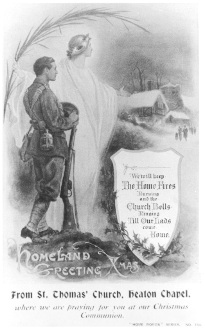 We have a 1915 post card for issue to overseas troops, with the message: We will keep the home fires burning and the Church Bells Ringing til our lads come home. Homeland Greeting Xmas. From St Thomas' Church Heaton Chapel. where we are praying for you at our Christmas Communion.
We have a 1915 post card for issue to overseas troops, with the message: We will keep the home fires burning and the Church Bells Ringing til our lads come home. Homeland Greeting Xmas. From St Thomas' Church Heaton Chapel. where we are praying for you at our Christmas Communion.
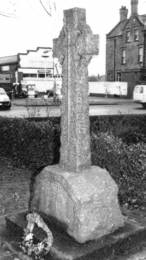
The first St Thomas electoral roll - the members of the Church who elect the P C C - in 1920 contained 222 names.
Following that first War, a war memorial in the form of a stone Celtic Cross was erected. Eight feet high, it has the image of a Crusader's sword.
In 1925, Miss G E Briscoe, an infants school teacher, was elected to the PCC. She continued to serve the church for many years.
A typical electric bill for this early period was eight pounds for three months, compared to GBP 22 for an average quarters bill in 1978.
A bible was presented by F H and A E F Shaw, in appreciation for Mr Sutcliffe's ministry.
Mr Sutcliffe died in Stockport in 1937.
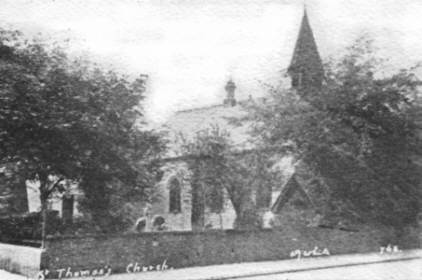
The church around 1924.
Memories of Frank Bradbury
The detached house then known as Buckingham was built at the corner of Wellington Road North and Buckingham Road shortly after Mr Sutcliffe's arrival in the Parish, and one of its first occupiers, then a small boy, was Mr Frank Bradbury, who has depicted the period thus:
At that time eveybody who could walk, young and old, went to Church dressed in their Sunday Best. It was quite a fashion parade. One or two families arrived by carriage, most walked, generally in whole families.
When I played truant, I could see from my bedroom window the congregation arrive, most of the ladies elegantly dressed and beautifully hatted, and many of their husbands in silk toppers. There was much bowing and bending and raising of hats.
There was usually a very good congregation, very intent on the service, after which many joined their friends on the parade along Heaton Moor Road, where many of them lived, in the large beautifully kept houses: for most of their owners were heads or directors of firms, mostly in Manchester.
On this fashionable parade some would be joined by their non-conformist friends, for the Presbyterians, the Congregationalists and the Wesleyans were very well attended too.
On Sunday afternoon many of the young people attended Sunday School, when there would be some appeal on behalf of some part of our far flung empire, which meant diving into our Sunday pockets. After Sunday School we had our own young peoples' parade along Heaton Moor Road or across the Golf Links.
Also at this time the first of three generations of Rupert Gurney arrived in Heaton Chapel, living on Manchester Road. The first Rupert Gurney built many of the houses now around the church, and was Mayor of Stockport in 1944. His son Rupert Gurney (born 1917) has kindly shared his memories of Heaton Chapel at this time. For Rupert's memories of the minister Mr Whatmough please see the article Memories of Rev Whatmough
I first went to St Thomas Church in 1922 with my Aunt and attended through to 1939.
I was involved, in many capacities throughout that time, when Rev, S. S. .Sutcliffe was the rector.
I attended church at the age of five and sat in the gallery by the organ loft, so
did not see much of the goings on. However I remember Mr.Sutcliffe who was
a kindly looking gentleman, who seemed very quiet. Often after
church he would pat me on the head as we came out
He was the epitome of a cleric, with a large black hat of panama shape, a dog collar, with a black coat and waistcoat --
black breeches and black shoes.
I only went to Morning Service which I thought were a bit dull. Morning Holy Communion was just once a month celebrated in with the
Morning Service. Not a large congregation, mainly steadfast families who paid an annual fee for their pew. Woe betide anyone brave enough to wander into
the pew by mistake, the wrath of the Verger would descend upon them.
The main focus of interest up to 1926 was centered upon the choir and organist. Any pamphlets available to visitors would quote " St Thomas is noted for its
singing. " The Choir consisted of a double Quartet paid professionals, excellent voices led by a Miss Lamb soprano and included a
Basso Profundo in Mr.Howkins; the indomitable Mr H.Greenwood being the organist.
Many of the congregation would remain after the Service to hear the completion of his Voluntary,especially if it was The Toccata and
Fugue.-played with great majesty. Choir Rehearsals were quite interesting; the choir would remain behind after Evensong to rehearse the Hymns,Psalms
and Anthem for the following Sunday-services, only if there was a special choral service or Choral Event would they meet on an evening. Little did Mr
Greenwood know what was in store for him in 1926. when the next incumbent was Rev. Frank Whatmough who was to institute many changes,Oh Boy! With many a
rumpus.
School: I went to St.Thomas School at the age of four. The teaching staff was Mr G. Bowers,Headmaster,Miss Cookson, infants,Miss Cossart and Miss Marsh 9 to 11 years ,Mr Cookson,Top Class 11-14 years of age.
Shops etc:
My Father set up a Building Business ,Gough and Gurney Ltd. They first built in Claremont Road, through to Egerton Road N,. This was followed by
Ellesmere Rd. I eventually lived at No1 Buckingham Road, next to the Church graveyard. Following this he built on the other side of the railway bridge, part of Tatton Road, Buckingham Road
and Peel Moat Road, finally adding Southgate, Downham Road and Bollington Road.
The original toll keeper [Toll house at junction of Wellington Road North and Manchester Road] had gone and the house was occupied by old Mr Geo.King.
His sons ran the greengrocers shop at the end of the toll bar grounds. Next to that shop was the Post Office and Telephone Exchange, run by Miss Cookson, sister of teacher
Cookson. After this came a Scots Plaid Shop, next was a newsagent and sweet shop lastly Ladleys the ironmonger.
Further up towards Cambridge Road was a Joiners Yard, a Smithy, The CoOp, whilst across the road John Williams, Riach the Pharmacist, and
Bentham the Barber.
Carrying on from Manchester Road. On the left hand side going up from Wellington Road.a new block of shops were built, Miss Caldwell had
the Haberdashers,then came the entrance to Meadows Road playing fields. Brealeys the ice cream makers was just down this entrance. Further along
Manchester Road was a wallpaper shop followed by a piece of land enclosed by the junction of Manchester Rd and Meadows Road. Situated inside this enclosure
was a most remarkable man: Mr.Penry Jones a most erudite person who was the local shoe repairer. His shop was in a converted single track tram
car such as the ones that ran from Manchester to Brooks Bar. The seating was along the length on both sides. Here local people would meet and
discuss all sorts of topics and in the school holidays I was permitted to sit in and listen, this being an education in its self.
View map of local area
There were originally no Buses - tramcars ran to Manchester along the Wellington Road. Some of the first buses in Heaton Chapel ran from Crossley Road to Stockport
along the old Manchester Road, another early route was from School Lane to Reddish, I remember going on its first journey the route
was then extended to Heaton Mersey.
I well remember the repairs to Manchester Road. The surface was of granite road blocks. The day arrived when the local council men commenced to take up
all the blocks from the Toll Bar up to School Lane. It was fascinating to see them take out the blocks, clean them all, and relay them. To bind them
they were rolled with a huge steam roller, then molten tar,taken from the huge tar boilers was poured into the joints. This was a labourious
job. The watchmans hut was positioned outside No 443. In the early evening my Grandfather would take out a flask of tes suitably laced with
whisky to the watchman, I was allowed into the hut to sit there and hear the chats between my Grandpa and the watchman, or Cocky as he was
called up North.
I have mentioned Meadows Rd. At the end of this road the fields stretched right the way down to Crossley Road tram terminus. The
roads Norfolk Avenue and Langdale Road both ran from Wellington Road to these fields. In Meadows Road lived the original owner of Belle Vue when it
was but a menagerie and fun fair, the owner was a Mr. Margerison.